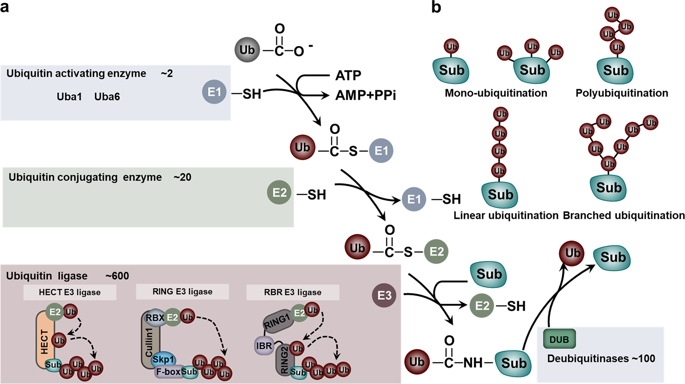当前位置:
X-MOL 学术
›
Signal Transduct. Target Ther.
›
论文详情
Our official English website, www.x-mol.net, welcomes your feedback! (Note: you will need to create a separate account there.)
The role of ubiquitination in tumorigenesis and targeted drug discovery.
Signal Transduction and Targeted Therapy ( IF 39.3 ) Pub Date : 2020-02-29 , DOI: 10.1038/s41392-020-0107-0 Lu Deng 1 , Tong Meng 2 , Lei Chen 3 , Wenyi Wei 4 , Ping Wang 5
Signal Transduction and Targeted Therapy ( IF 39.3 ) Pub Date : 2020-02-29 , DOI: 10.1038/s41392-020-0107-0 Lu Deng 1 , Tong Meng 2 , Lei Chen 3 , Wenyi Wei 4 , Ping Wang 5
Affiliation

|
Ubiquitination, an important type of protein posttranslational modification (PTM), plays a crucial role in controlling substrate degradation and subsequently mediates the "quantity" and "quality" of various proteins, serving to ensure cell homeostasis and guarantee life activities. The regulation of ubiquitination is multifaceted and works not only at the transcriptional and posttranslational levels (phosphorylation, acetylation, methylation, etc.) but also at the protein level (activators or repressors). When regulatory mechanisms are aberrant, the altered biological processes may subsequently induce serious human diseases, especially various types of cancer. In tumorigenesis, the altered biological processes involve tumor metabolism, the immunological tumor microenvironment (TME), cancer stem cell (CSC) stemness and so on. With regard to tumor metabolism, the ubiquitination of some key proteins such as RagA, mTOR, PTEN, AKT, c-Myc and P53 significantly regulates the activity of the mTORC1, AMPK and PTEN-AKT signaling pathways. In addition, ubiquitination in the TLR, RLR and STING-dependent signaling pathways also modulates the TME. Moreover, the ubiquitination of core stem cell regulator triplets (Nanog, Oct4 and Sox2) and members of the Wnt and Hippo-YAP signaling pathways participates in the maintenance of CSC stemness. Based on the altered components, including the proteasome, E3 ligases, E1, E2 and deubiquitinases (DUBs), many molecular targeted drugs have been developed to combat cancer. Among them, small molecule inhibitors targeting the proteasome, such as bortezomib, carfilzomib, oprozomib and ixazomib, have achieved tangible success. In addition, MLN7243 and MLN4924 (targeting the E1 enzyme), Leucettamol A and CC0651 (targeting the E2 enzyme), nutlin and MI-219 (targeting the E3 enzyme), and compounds G5 and F6 (targeting DUB activity) have also shown potential in preclinical cancer treatment. In this review, we summarize the latest progress in understanding the substrates for ubiquitination and their special functions in tumor metabolism regulation, TME modulation and CSC stemness maintenance. Moreover, potential therapeutic targets for cancer are reviewed, as are the therapeutic effects of targeted drugs.
中文翻译:

泛素化在肿瘤发生和靶向药物发现中的作用。
泛素化是一种重要的蛋白质翻译后修饰(PTM)类型,在控制底物降解过程中起着至关重要的作用,并随后介导各种蛋白质的“数量”和“质量”,从而保证细胞稳态和生命活动。泛素化的调节是多方面的,不仅在转录和翻译后水平(磷酸化、乙酰化、甲基化等)而且在蛋白质水平(激活剂或阻遏物)上起作用。当调节机制异常时,改变的生物过程可能随后诱发严重的人类疾病,尤其是各种类型的癌症。在肿瘤发生中,改变的生物学过程涉及肿瘤代谢、免疫肿瘤微环境(TME)、癌症干细胞(CSC)干性等。在肿瘤代谢方面,一些关键蛋白如 RagA、mTOR、PTEN、AKT、c-Myc 和 P53 的泛素化显着调节了 mTORC1、AMPK 和 PTEN-AKT 信号通路的活性。此外,TLR、RLR 和 STING 依赖性信号通路中的泛素化也调节 TME。此外,核心干细胞调节剂三联体(Nanog、Oct4 和 Sox2)以及 Wnt 和 Hippo-YAP 信号通路成员的泛素化参与了 CSC 干性的维持。基于改变的成分,包括蛋白酶体、E3 连接酶、E1、E2 和去泛素酶 (DUB),已经开发出许多分子靶向药物来对抗癌症。其中,以蛋白酶体为靶点的小分子抑制剂,如硼替佐米、卡非佐米、奥普佐米和伊沙佐米等均取得了实实在在的成功。此外,MLN7243 和 MLN4924(靶向 E1 酶)、Leucettamol A 和 CC0651(靶向 E2 酶)、nutlin 和 MI-219(靶向 E3 酶)以及化合物 G5 和 F6(靶向 DUB 活性)在临床前癌症中也显示出潜力治疗。在这篇综述中,我们总结了理解泛素化底物及其在肿瘤代谢调节、TME 调节和 CSC 干细胞维持中的特殊功能的最新进展。此外,还审查了癌症的潜在治疗靶点,以及靶向药物的治疗效果。我们总结了在理解泛素化底物及其在肿瘤代谢调节、TME 调节和 CSC 干细胞维持中的特殊功能方面的最新进展。此外,还审查了癌症的潜在治疗靶点,以及靶向药物的治疗效果。我们总结了在理解泛素化底物及其在肿瘤代谢调节、TME 调节和 CSC 干细胞维持中的特殊功能方面的最新进展。此外,还审查了癌症的潜在治疗靶点,以及靶向药物的治疗效果。
更新日期:2020-02-29
中文翻译:

泛素化在肿瘤发生和靶向药物发现中的作用。
泛素化是一种重要的蛋白质翻译后修饰(PTM)类型,在控制底物降解过程中起着至关重要的作用,并随后介导各种蛋白质的“数量”和“质量”,从而保证细胞稳态和生命活动。泛素化的调节是多方面的,不仅在转录和翻译后水平(磷酸化、乙酰化、甲基化等)而且在蛋白质水平(激活剂或阻遏物)上起作用。当调节机制异常时,改变的生物过程可能随后诱发严重的人类疾病,尤其是各种类型的癌症。在肿瘤发生中,改变的生物学过程涉及肿瘤代谢、免疫肿瘤微环境(TME)、癌症干细胞(CSC)干性等。在肿瘤代谢方面,一些关键蛋白如 RagA、mTOR、PTEN、AKT、c-Myc 和 P53 的泛素化显着调节了 mTORC1、AMPK 和 PTEN-AKT 信号通路的活性。此外,TLR、RLR 和 STING 依赖性信号通路中的泛素化也调节 TME。此外,核心干细胞调节剂三联体(Nanog、Oct4 和 Sox2)以及 Wnt 和 Hippo-YAP 信号通路成员的泛素化参与了 CSC 干性的维持。基于改变的成分,包括蛋白酶体、E3 连接酶、E1、E2 和去泛素酶 (DUB),已经开发出许多分子靶向药物来对抗癌症。其中,以蛋白酶体为靶点的小分子抑制剂,如硼替佐米、卡非佐米、奥普佐米和伊沙佐米等均取得了实实在在的成功。此外,MLN7243 和 MLN4924(靶向 E1 酶)、Leucettamol A 和 CC0651(靶向 E2 酶)、nutlin 和 MI-219(靶向 E3 酶)以及化合物 G5 和 F6(靶向 DUB 活性)在临床前癌症中也显示出潜力治疗。在这篇综述中,我们总结了理解泛素化底物及其在肿瘤代谢调节、TME 调节和 CSC 干细胞维持中的特殊功能的最新进展。此外,还审查了癌症的潜在治疗靶点,以及靶向药物的治疗效果。我们总结了在理解泛素化底物及其在肿瘤代谢调节、TME 调节和 CSC 干细胞维持中的特殊功能方面的最新进展。此外,还审查了癌症的潜在治疗靶点,以及靶向药物的治疗效果。我们总结了在理解泛素化底物及其在肿瘤代谢调节、TME 调节和 CSC 干细胞维持中的特殊功能方面的最新进展。此外,还审查了癌症的潜在治疗靶点,以及靶向药物的治疗效果。


























 京公网安备 11010802027423号
京公网安备 11010802027423号